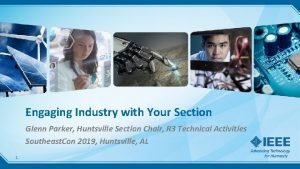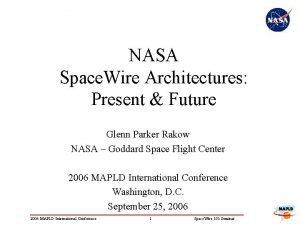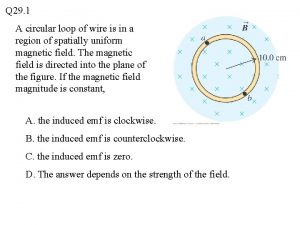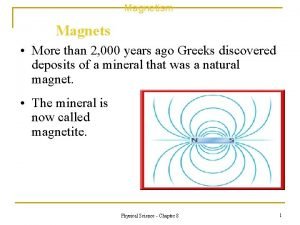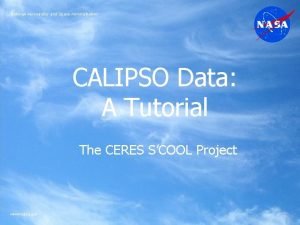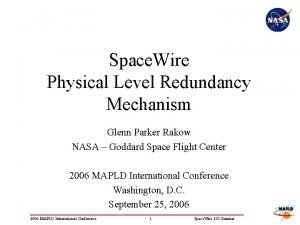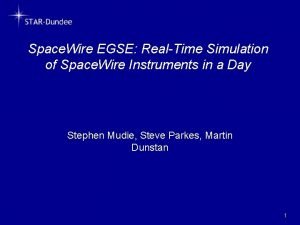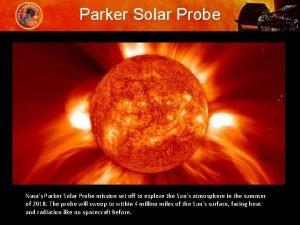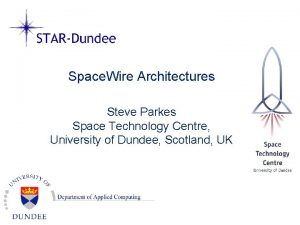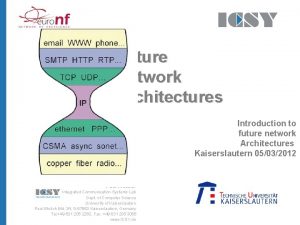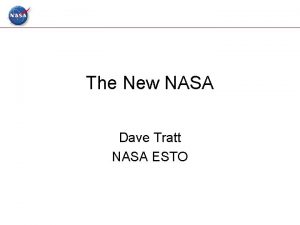NASA Space Wire Architectures Present Future Glenn Parker










- Slides: 10

NASA Space. Wire Architectures: Present & Future Glenn Parker Rakow NASA – Goddard Space Flight Center 2006 MAPLD International Conference Washington, D. C. September 25, 2006 MAPLD International Conference 1 Space. Wire 101 Seminar

Current Space. Wire Architectures: Swift Data Flow Instrument CDH • Space. Wire point-to-point links • 16 links from segmented detector array & readout Electronics to Instrument CDH • Science Data & Commands Spacecraft Back-plane Cmd Bus 1553 CDH ACS Processor • PCI • Instrument CDH to Memory DSP • Memory to DSP Mem • MIL-STD-1553 • CMD bus to Spacecraft Sp. W 2006 MAPLD International Conference 2 16 Detectors & Instrument Readout Electronics Space. Wire 101 Seminar

Current Space. Wire Architectures: LRO Data Flow • Routed Space. Wire traffic • End-node routers on C&DH boards Instr A –Used as Serial backplane Space. Wire Instr B Xpndr Instr C Hi-Rate HGA Xmtr Space. Wire Router » Single Board Computer Board Low Rate/ Unique serial bus » Instrument Interface Board Low -Rate » S-Band Communication Board » Ka-Band Communications Board • Interface to moderate instruments • Not memory mapped like RMAP or GAP • Side band signaling using Time-Codes – 1 pps Space. Wire Router Power Processor Supply –Barker code detect – uplink Parallel Bus Memory IO Space. Wire Router High Low rate Comm Parallel Bus –Upper level flow control on downlink frames Backplane • MIL-STD-1553 C&DH • Interface to spacecraft subsystem • Used for low-rate heritage instruments 2006 MAPLD International Conference 3 Space. Wire 101 Seminar

Current Space. Wire Architectures: JWST Data Flow FPE # 2 FPE # 3 FPE # 4 FPE # 5 2006 MAPLD International Conference 4 Space. Wire 101 Seminar

Current Space. Wire Architectures • JWST – Routed Space. Wire traffic • From 4 instruments to local router to end node router (Instrument C&DH [IC&DH]) (cable) • ICDH end node router to hardware processors (same box over backplane) • Hardware processors to compression engine (same box over backplane) • Compression engine to recorder (cable) • GOES-R – Point-to-point links – Instrument - C&DH with Reliable Data Delivery Protocol 2006 MAPLD International Conference 5 Space. Wire 101 Seminar

• • • Different physical interfaces using different protocols that require unique hardware and software to bridge between them Serial interface at one point per enclosure @ NIC Extra board area and more power for multiple interfaces Only boards in same enclosure have memory mapped access via arbitration Enclosures represent limited access Reuse & reconfigurability limited Traditional Systems Purple Red Black Purple Blue Purple Black 2006 MAPLD International Conference Legend: Red – High-speed interface Black – Discrete sync pulse Blue – TDMA low rate bus (MIL_STD-1553) Purple – Parallel Backplane 6 Space. Wire 101 Seminar

Future Systems Blue Lt. Blue Red Blue • • Same protocols supported across both physical interfaces Space. Wire and Space. Fibre Bridged by hardware router Red Low-level protocols (RMAP & GAP) for memory mapped DMA or single transactions – no software required & blurs enclosure boundaries Plug and Play network mapping and Change-of-Status indication supported in hardware – • Coming soon! Tunnel higher layer protocols 2006 MAPLD International Conference Non-Blocking Cross-Bar Switch Blue Red Lt. Blue Hardware bridge Between Space. Wire & Space. Fibre Legend: Red – Space. Fibre (optical or copper) Blue – Space. Wire Lt Blue – Local port interface (parallel) 7 Space. Wire 101 Seminar

Advantages • One communications infrastructure – – Simplifies system design Consists of 2 different physical layers • • • Space. Wire Space. Fibre Bridged in hardware via routing switch – • Supports low-level & high-level protocols • Virtual serial backplanes • Upper layer protocol may be identified – – • RMAP & GAP Via Protocol ID (PID) Low latency bus – • Seamless integration Wormhole routing Side-Band signaling – – Reducing number of interfaces Time-Code enhancements • Pending • May be used as a time-triggered or event triggered bus • – Time-triggered via Time-code defined slots Command bus features have been addressed • Cable redundancy (presented later) – • Transparent mechanism has been implemented » Proposed for standardization Data retries – Protocol ID (PID) can accommodate Retry protocols » MIL-STD-1553 over Space. Wire (no PID assigned) » Reliable Data Delivery Protocol (RDDP) (no PID assigned) 2006 MAPLD International Conference 8 Space. Wire 101 Seminar

System Engineer Toolkit • Buffers match packet size • Optimize throughput • Router blockage prevention • Time-out • Max length • Full Duplex • Cmd & Tlm opposite directions • Priority routing • Dedicated link for low latency TLM Space. Fiber (cell based virtual channels) • Long distance • Isolation • EMC/EMI • Bridge to Sp. W via hardware router CMD Space. Fiber • Redundant cables • High Rate Group Adaptive Routing Across multiple Sp. W links • Multiple Sp. W local ports to prevent blocking; increase throughput • Redundant paths • Message sharing • Time-critical network • Consensus computing • Time-codes • Near zero-jitter across entire network • Synchronization • TDMA • 1 pps • Time-Code expansion • Interrupts • Polling • Multi-Time. Code Group Adaptive Routing • Multiple Sp. W links 2006 MAPLD International Conference 9 Space. Wire 101 Seminar

Conclusions • Simple protocol that is being developed from bottom up to meet advanced spacecraft applications • One bus standard can meet requirements – Real time control – Large data throughput – Safety • Guaranteed Low latency • High reliability • Reuse & reconfiguration of systems easier with standard interface – Modular functions with standard interface • Serial interface – cable – backplane • Provide system engineers more “tools” for more efficient designs 2006 MAPLD International Conference 10 Space. Wire 101 Seminar
